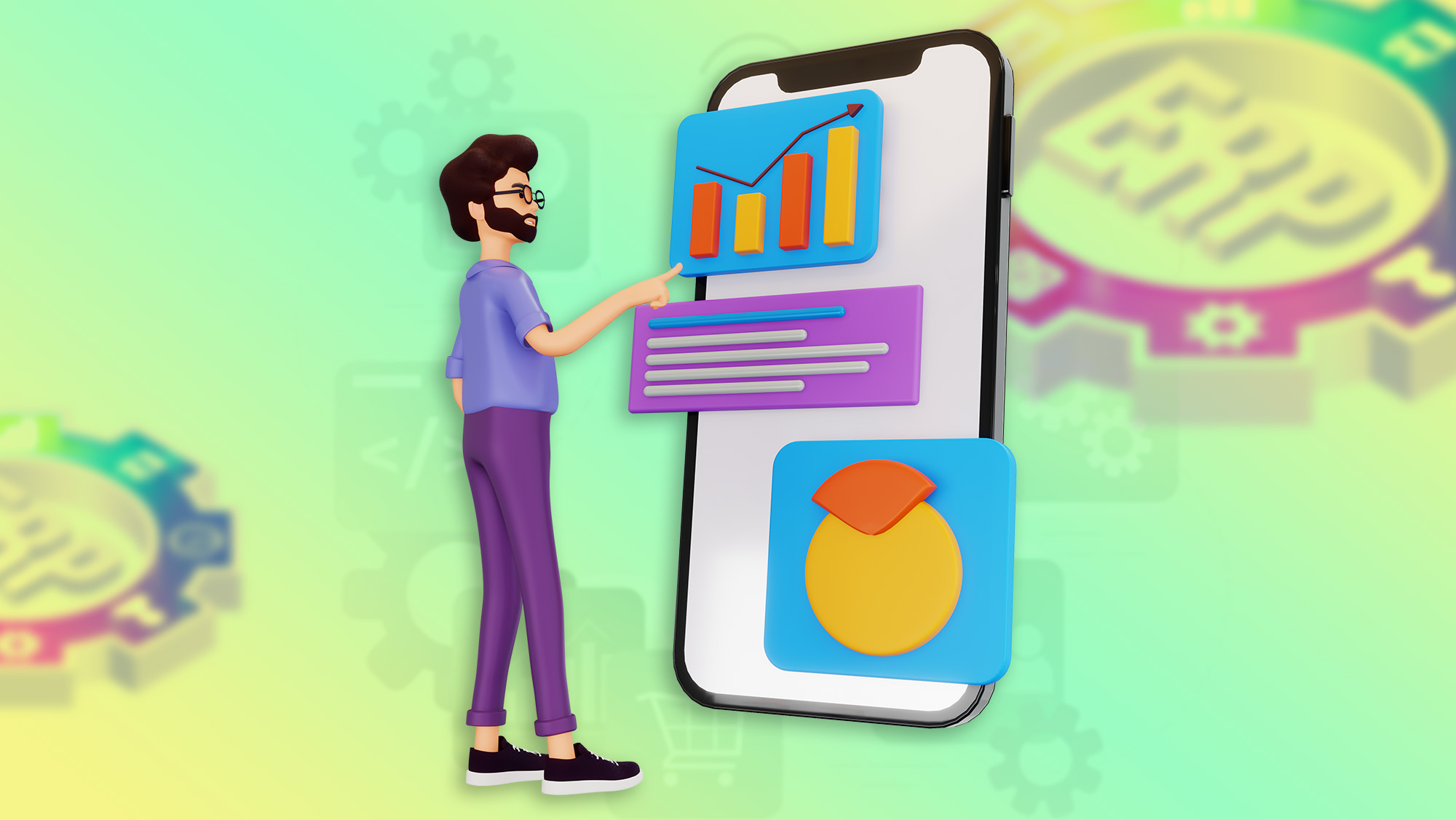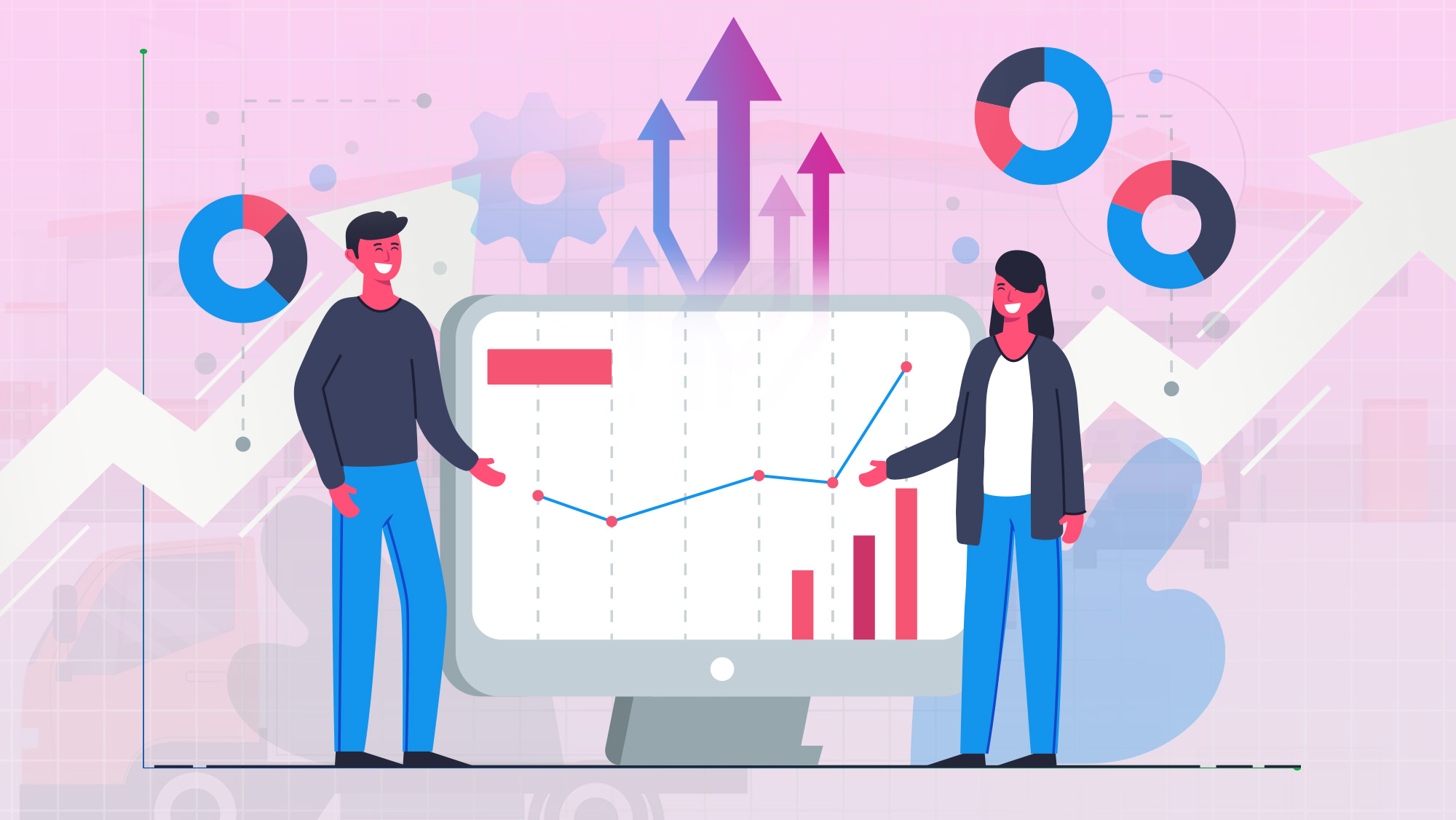Table of Content
ERP Market witnessed a staggering growth rate of 12.3% in the previous year. Industries involved in production, distribution, and sales, such as manufacturing, have proactively addressed all emerging obstacles through the implementation of ERP solutions.
Businesses have now realized the importance of ERP solutions, leading to a continuous rise in their adoption with each passing day. Nevertheless, 95% of the organizations have ended up choosing an ERP system, which is not even compatible with their requirements.
As a result, they failed to meet the growth expectations of their business.
Have you faced a similar situation before? If you have, you might understand the potential risks that can arise in a business environment when an incorrect ERP system and vendor are chosen.
Make it a point to steer clear of this error by reading this blog till the end. Enhance your reading experience with your preferred beverage!
Henceforth, it's quite crucial to know the criteria when it comes to making a worthwhile investment in an ERP solution. Getting your hands on the right ERP solution doesn’t have to be cumbersome, however, we are going to assist you step-by-step.
After reading this blog, you are going to have clarity on pre-defined criteria for selecting the right ERP system and vendor.
All set to know the tips for selecting the right ERP solutions in 2024?
Let’s get started!
Consider These Points in your ERP Selection Criteria in 2024 and beyond
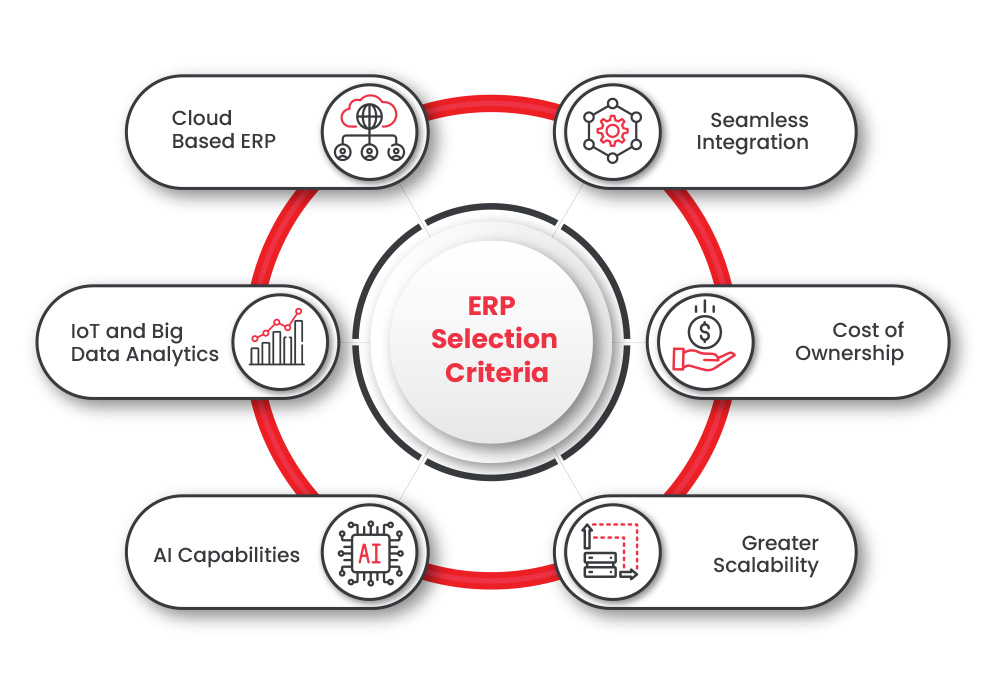
Companies while developing ERP software consider all the business requirements and add new functionalities to empower businesses to perform well. Some ERP manufacturers like Microsoft focus on adding new capabilities or innovations every year, while others after 2 to 3 years.
Consider the below-mentioned pointers for ERP selection criteria.
Focus on Cloud-Based ERP Solutions
Businesses that are switching from on-prem ERP to cloud are greater in number due to various incredible benefits of cloud technology. Cloud ERP is quite cost-effective and time-saving.
For example: Businesses no longer need to invest in costly physical hardware, and IT experts need to operate the ERP system effectively. The entire ERP system will be managed by either the ERP company or vendor, especially if you collaborate with Microsoft ERP Solutions.
Furthermore, as per the Statista report, the estimated compound annual growth rate (CAGR) for global Cloud ERP revenue is set at 13%, propelling the figures from USD 14.7 billion in 2018 to a substantial USD 40.5 billion by 2025.
So, what does this report mean? It’s a good sign, which is unfolding the exponential growth of Cloud ERP technology. This shouldn’t be overlooked at any cost.
If you haven’t switched from on-prem ERP to Cloud then, it’s high time to act now!
Fusion of Cutting-Edge IoT and Big Data Analytics Capabilities into the ERP
The integration of cutting-edge IOT and Big Data analytics capabilities into the ERP is the latest trend in the market. This fusion makes ERP a powerful tool that not only streamlines operations but also provides a deeper understanding of business trends and customer behaviors. This amazing edition of the ERP system unlocks new avenues for growth, efficiency, and competitiveness, making it a game-changer in the realm of enterprise management.
Next-gen AI Capabilities
The ERP system should be powered by Next-gen AI capabilities to take your business growth to the next level. It empowers businesses with enhanced customer insights, personalized engagement, automated support, and optimized workflows.
Besides, it enables predictive maintenance, data-driven decision-making, fraud detection, and improved employee productivity. These AI-driven features enhance efficiency, customer satisfaction, and strategic decision-making across various business functions.
Seamless Integration with Existing Systems
Choose an ERP system that facilitates smooth integration with other existing systems in your business. The integration of the chosen ERP solution with existing systems ensures accurate data flow, streamlined processes, and real-time insights.
This enhances efficiency, resource allocation, and customer experiences while reducing errors and IT complexity. The integration enables compliance, scalable growth, cost savings, and competitive advantage through improved decision-making and holistic visibility.
Total Cost of Ownership (TCO)
When selecting an ERP solution, considering the total cost of ownership (TCO) is critical to making an informed decision. TCO encompasses not only the upfront software and implementation costs but also ongoing expenses over the system's lifecycle.
Henceforth, evaluate these below mentioned key factors carefully:
- Software Licensing: Understand licensing fees, user-based costs, and potential scalability charges. Compare options for perpetual licenses vs. subscription models.
- Implementation and Customisation: Estimate costs for implementation, data migration, and system configuration. Customization needs may add to expenses; assess the complexity and associated costs.
- Integration: Account for integration costs with existing systems, middleware, and third-party applications. Integration complexity affects expenses.
- Training and Change Management: Budget for user training, change management support, and potential downtime during the transition. Employee adaptation affects efficiency.
- Maintenance and Support: Consider ongoing maintenance fees, updates, and technical support. Evaluate vendor service-level agreements (SLAs).
- Infrastructure and Hosting: Assess hardware, server, and cloud hosting expenses. Cloud solutions may have subscription-based costs.
- Upgrades and Enhancements: Account for future upgrades, enhancements, and associated costs to keep the system up to date.
- Operational Disruption: Consider potential productivity losses during implementation and migration, which may affect revenue.
- Consulting and Professional Services: Budget for external consulting, expert advice, or additional services needed during implementation or operation.
- Hidden Costs: Anticipate unforeseen expenses related to data cleansing, hardware upgrades, additional modules, or compliance requirements.
- ROI and Long-Term Benefits: Evaluate how the ERP's features contribute to productivity gains, cost savings, and revenue growth over time.
- Vendor Selection: Choose a reputable vendor with a transparent pricing model and a history of reliable support.
Don't you think all the above-mentioned costs should be transparent before making a final investment in an ERP system? Yes, don’t forget to get clarity on this aspect from your ERP vendor.
Greater Scalability
One should select an ERP solution that is easily scalable for accommodating business growth, increased data volumes, and evolving needs. A scalable ERP ensures seamless integration of new processes, users, and technologies, maintaining efficiency and performance.
It minimizes disruptions, optimizes resource allocation, and supports long-term competitiveness, adapting to changing demands without requiring a complete overhaul.
For example:
Imagine a retail company implementing an ERP system to manage its operations. Initially, the company had a few stores and limited product lines. However, as the business expands, the ERP's scalability becomes evident.
New stores are effortlessly integrated into the system, with inventory, sales, and customer data seamlessly flowing in real time. When the holiday season hits, and sales surge, the scalable ERP handles the increased transaction volume without slowdowns.
As the company diversifies into e-commerce, the ERP easily integrates into the online platform. This scalability ensures uninterrupted growth, efficient resource utilization, and sustained customer satisfaction.
Related Posts - ERP Implementation Plan, Methodology & Challenges
How do ERP Applications in Dynamics 365 Align with the Stated ERP Criteria?
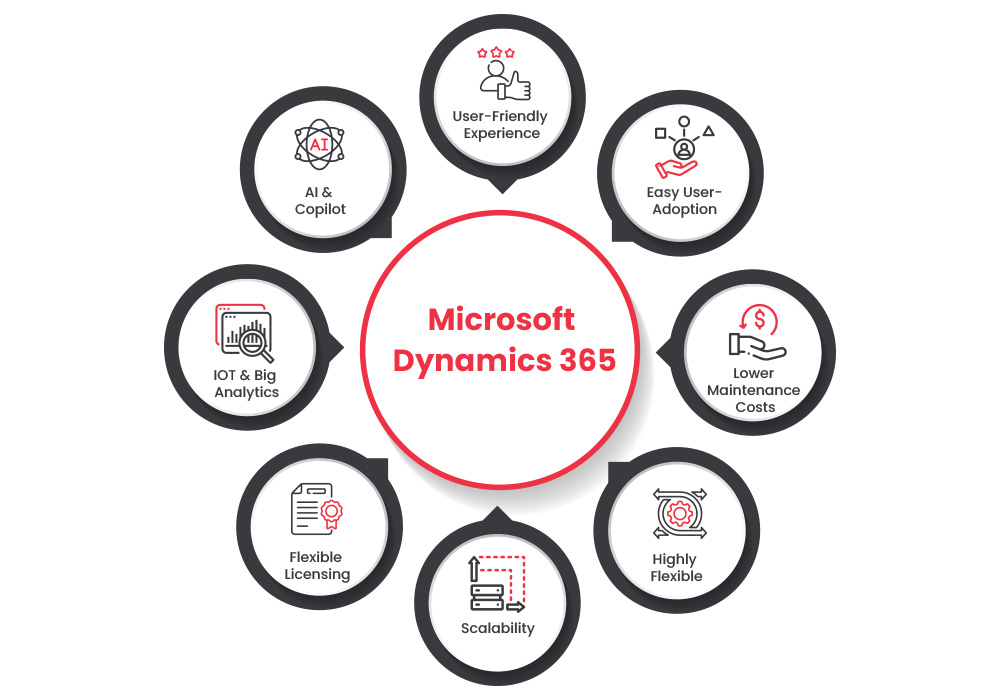
User-Friendly Experience
The user-friendly interface of Microsoft Dynamics 365 ERP applications provides users with a native app-like experience. This experience makes the applications easy to learn and use, eliminating the exhaustive training sessions needed by the other ERP solutions.
Easy User-Adoption
Dynamics 365 seamlessly integrates with the familiar Microsoft 365 suite of applications, including Outlook, Teams, Excel and PowerPoint, and Microsoft Power Platform. This integration facilitates smoother user adoption while ensuring security with its robust security features.
Lower Maintenance Costs in Long-Run
Handling the hosting, maintenance, and updates in the cloud, Microsoft allows your internal team to work smoothly without the burden of AMC or hardware, licenses, and data servers' maintenance costs and efforts. It eliminates the need for any resources (in-house experts) to maintain the system, resulting in substantial cost savings for the company.
Highly Flexible
Dynamics 365 solutions are flexible enough to undergo customisation to cater to specific business requirements. After implementing this, the solutions require minimal customisation due to their inherent advanced features and rich functionalities to satisfy unique business needs.
Scalability
Dynamics 365 solutions offer scalability to accommodate the needs of growing businesses. Regular updates from Microsoft ensure Dynamics 365 features stay updated with the latest technology advancements to cater to evolving business requirements.
Flexible Licensing Options
Dynamics 365 solutions have a flexible pricing structure, as the users can subscribe to only the applications they use. The flexible licensing options allow businesses to choose specific modules according to their requirements.
In-Built IOT & Big Analytics Capabilities
Microsoft offers a comprehensive suite of IOT solutions, enabling businesses to connect, monitor, and manage their devices, assets, and operations in real time. Microsoft's Big Data Analytics capabilities are primarily centered around its Azure platform. Additionally, Power BI, Microsoft's business intelligence tool, empowers users to visualize data and extract meaningful insights for informed decision-making.
AI & Copilot Capabilities
AI capabilities encompass features like predictive analytics, machine learning, and natural language processing, enabling the system to understand, analyze, and act on data more intelligently. Copilot features involve AI-powered assistance during tasks, such as suggesting responses, offering insights, and automating routine processes. Microsoft Dynamics 365 has these two functionalities. These in-built capabilities collectively aim to improve decision-making, customer engagement, efficiency, and overall user experience within Dynamics 365 applications.
Related Posts - Microsoft Dynamics 365 Co-Pilot
What are the Criteria for Selecting ERP Vendors?
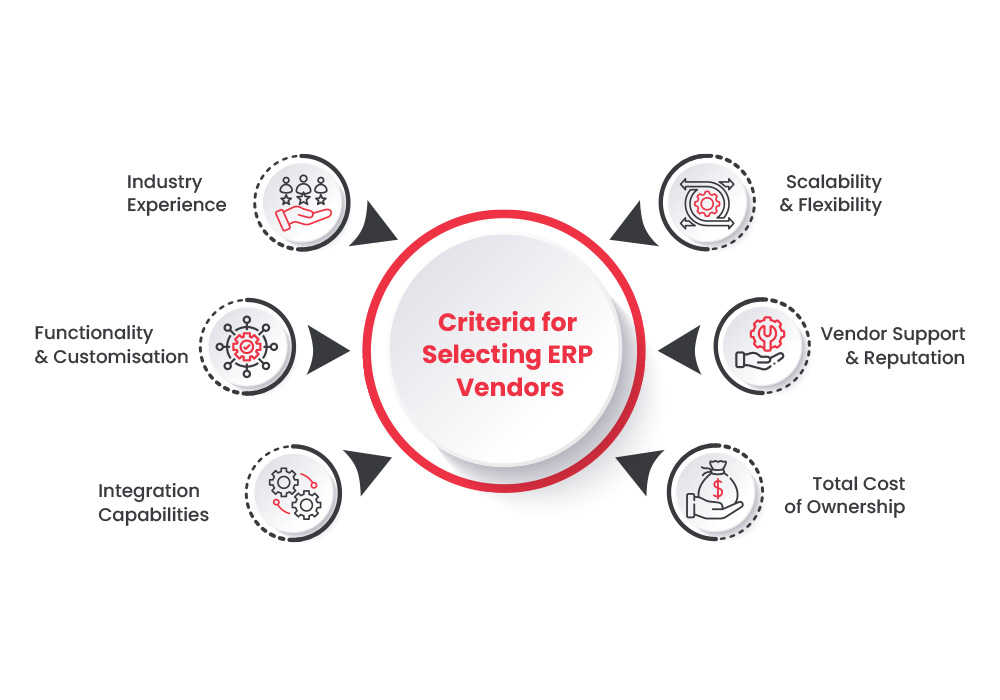
Selecting the right ERP vendor is a critical decision that can impact your organization's efficiency and success. Here are six essential points that one must include in their ERP implementation partner selection criteria.
- Industry Experience: Look for vendors with a proven track record in your industry. Experience in similar sectors ensures a deeper understanding of your specific needs and challenges.
- Functionality and Customisation: Assess the ERP system's core functionalities and its ability to accommodate your unique requirements. The vendor should offer customisation options without compromising the software's stability.
- Integration Capabilities: Ensure the ERP system can seamlessly integrate with your existing software landscape, including financial, HR, and CRM systems, to maintain data accuracy and streamline processes.
- Scalability and Flexibility: Choose a vendor whose ERP solution can grow with your organization. Scalability is crucial as your business evolves, expands, and potentially enters new markets.
- Vendor Support and Reputation: Evaluate the vendor's customer support services, including post-implementation assistance, updates, and training. Research their reputation within your industry and read client testimonials.
- Total Cost of Ownership (TCO): Consider both the initial investment and the long-term costs associated with implementing and maintaining the ERP system. Ensure transparency in pricing, licensing, customization, and ongoing support.
By thoroughly evaluating ERP vendors based on the above criteria, you can make an informed decision that aligns with your organization's goals and sets the stage for a successful ERP implementation.
Related Posts - ERP Requirement Checklist
How Does Dynamics Square Align with the Aforementioned ERP Vendor Selection Criteria?
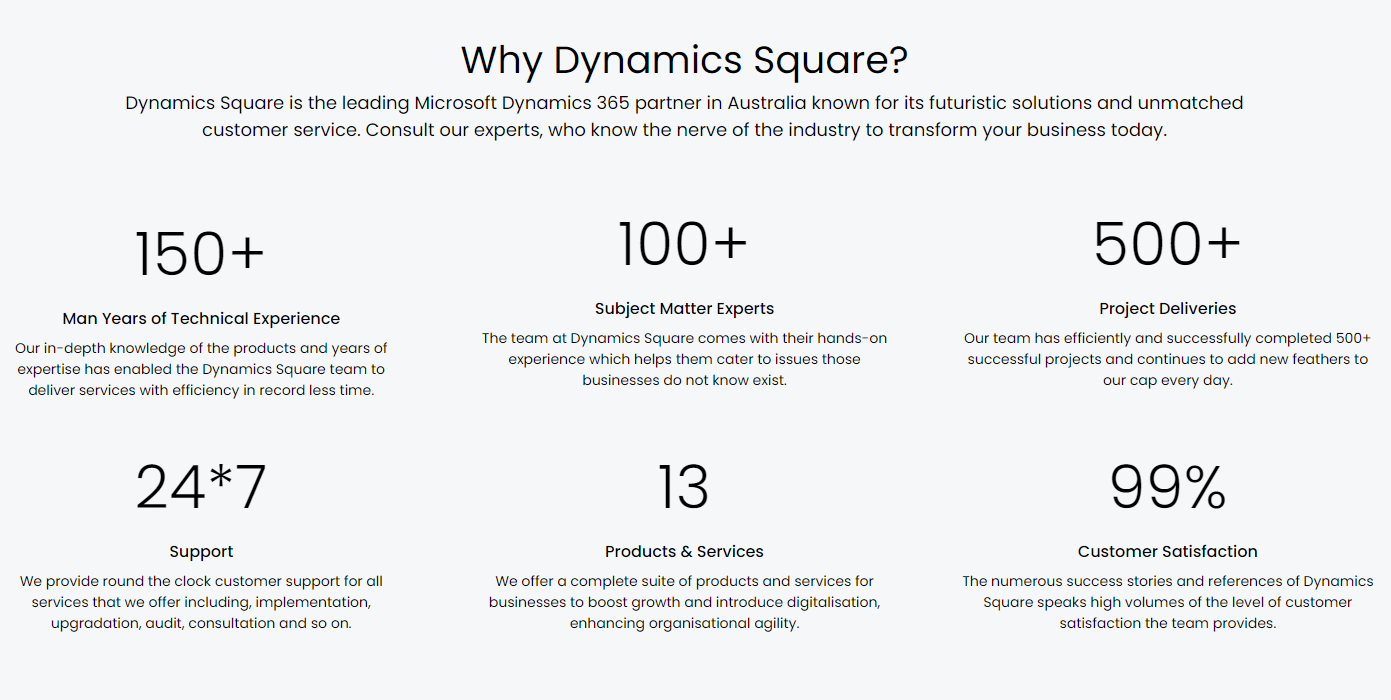
Here are several reasons that demonstrate why selecting Dynamics Square as your ERP vendor is an excellent decision, marking it as the finest choice you've ever made for collaboration.
- Microsoft Solutions Specialist: For 15 years, we have specialized in Microsoft Dynamics 365 solutions, mastering their capabilities to tackle industry challenges seamlessly, and effectively.
- IT Solution Partner Designation: Microsoft has given the solution partner designation to Dynamics Square to provide business management solutions to small and mid-sized businesses.
- 99% Customer Retention Rate: Dynamics Square has over 500+ customers across Australia, with 99% customer retention.
- Tier 1 Technology Consulting: Dynamics Square became the tier 1 technology service provider with a global footprint.
- Strategic IT Partner: Rather than just being a system implementation partner, Dynamics Square serves as the strategic IT partner for the customers. We are a one-stop shop for our customers.
- 100+ Microsoft-Certified Professionals: Dynamics Square has a strong core team of more than 100 Microsoft-certified professionals.
- Supporting Three Major Product Lines: The core team has cross-functional expertise as they can support all three product lines: Dynamics 365 Business Central, Dynamics 365 Finance and Supply Chain Management, and Dynamics 365 Customer Relationship Management.
- Zero-Defect Policy: At Dynamics Square, we are committed to maintaining absolute clarity with our customers by adhering to a zero-defect policy. This means that we guarantee our clients the successful completion of their ERP implementation project within their specified budget constraints.
- Strong Customer Reference: Dynamics Square has strong customer references in Australia.
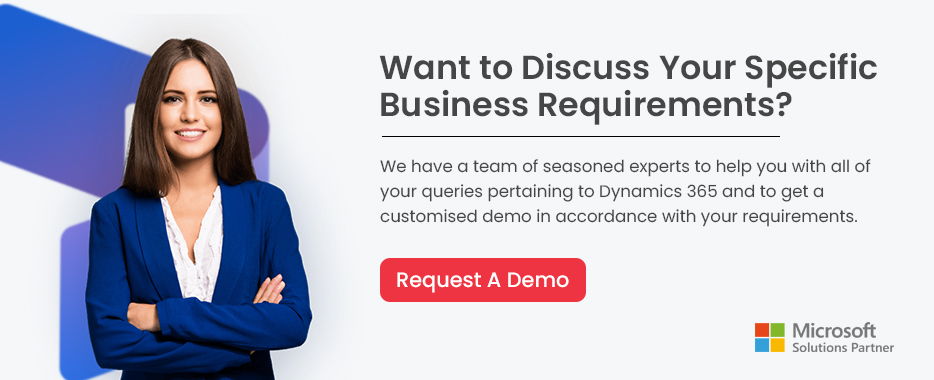
Related Posts - How to Choose the Right Microsoft Dynamics 365 Partner?
Questions to Ask ERP Vendors

When evaluating potential ERP vendors, asking the right questions is crucial to ensure you choose the solution that best fits your organization's needs. Here are key questions to ask ERP vendors during the selection process:
How Does Your ERP Solution Address Our Industry Needs?
Inquire about the vendor's experience and success in your specific industry.
Ask for examples of how their solution has helped organizations with similar challenges.
What Core Functionalities Does Your ERP System Offer?
Seek a comprehensive overview of the ERP's modules and features.
Determine whether these functionalities align with your organization's processes and goals.
How Flexible Is Your System for Customization?
Inquire about the extent of customization possible without affecting the system's stability.
Ask for examples of customized solutions for organizations with unique needs.
How Does Your ERP System Handle Data Security and Compliance?
Ask about security measures, access controls, encryption, and audit trails.
Ensure the ERP system complies with relevant industry regulations and standards.
Can You Explain Your Pricing Structure and Total Cost of Ownership (TCO)?
Request a breakdown of costs, including licensing, implementation, customization, and maintenance.
Clarify any potential hidden costs that might arise during the implementation process.
What Is Your Implementation Process and Timeline?
Understand the steps involved in implementing the ERP solution.
Discuss a realistic timeline for deployment, considering your organization's size and complexity.
Asking these questions will provide you with valuable insights into each ERP vendor's capabilities, compatibility with your organization's needs, and commitment to your success. Use these responses to make an informed decision that aligns with your long-term strategic goals.
How to Hold a Successful ERP Software Demo?

Certainly, here are six essential points for holding a successful ERP software demo:
- Clear Objectives: Define your organization's objectives and pain points beforehand to tailor the demo's focus to your specific needs.
- Customized Agenda: Collaborate with the vendor to create a demo agenda that highlights features relevant to your industry and workflows.
- Engage Stakeholders: Invite cross-functional team members to attend and provide diverse perspectives during the demo.
- Realistic Scenarios: Provide real business scenarios encountered by you and ask them how the ERP software addresses these daily challenges.
- User Experience: Evaluate the software's user interface and usability to ensure it aligns with your team's needs and capabilities.
- Support and Integration: Inquire about post-implementation support, data integration, and customization options to meet your organization's requirements.
Final Thoughts
Navigating the 2024 landscape demands the most scalable ERP choice. Tune into your needs, fuel growth with scalability, and lock in unwavering vendor backing. Unleash the potential of cloud solutions for unmatched agility. Prioritize user-centric design, seamless integration, and long-haul relevance for an ERP that becomes your competitive edge.
With the above write-up’s mentioned guidelines, surge ahead into a future where your business not only survives but thrives. Note that today’s ERP choice is the launchpad for your prosperous or successful tomorrow.

Witness a scalable transformation
Experience real-time synchronisation and flexibility with a consistent view across your business.
Disclaimer– “All data and information provided on this blog is for informational purposes only. Dynamics Square / MPG Business Information Systems Pvt. Ltd. makes no representations as to accuracy, completeness, currentness, suitability, or validity of any information on this site and will not be liable for any errors, omissions, or delays in this information or any losses, injuries, or damages arising from its display or use.”

